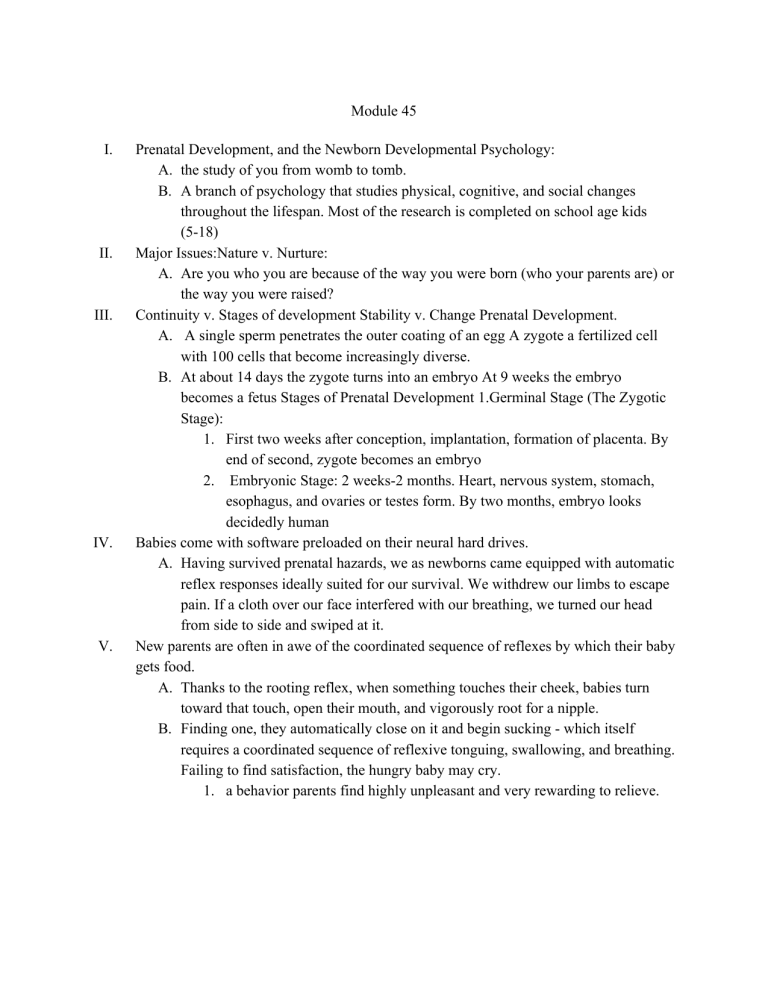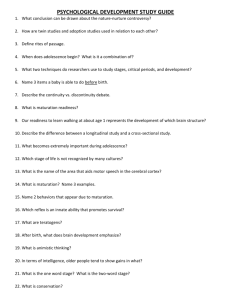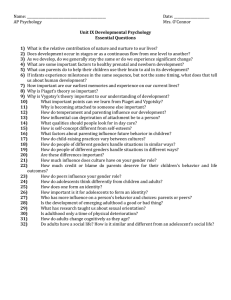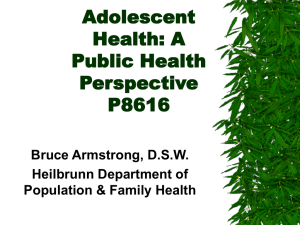
Module 45 I. II. III. IV. V. Prenatal Development, and the Newborn Developmental Psychology: A. the study of you from womb to tomb. B. A branch of psychology that studies physical, cognitive, and social changes throughout the lifespan. Most of the research is completed on school age kids (5-18) Major Issues:Nature v. Nurture: A. Are you who you are because of the way you were born (who your parents are) or the way you were raised? Continuity v. Stages of development Stability v. Change Prenatal Development. A. A single sperm penetrates the outer coating of an egg A zygote a fertilized cell with 100 cells that become increasingly diverse. B. At about 14 days the zygote turns into an embryo At 9 weeks the embryo becomes a fetus Stages of Prenatal Development 1.Germinal Stage (The Zygotic Stage): 1. First two weeks after conception, implantation, formation of placenta. By end of second, zygote becomes an embryo 2. Embryonic Stage: 2 weeks-2 months. Heart, nervous system, stomach, esophagus, and ovaries or testes form. By two months, embryo looks decidedly human Babies come with software preloaded on their neural hard drives. A. Having survived prenatal hazards, we as newborns came equipped with automatic reflex responses ideally suited for our survival. We withdrew our limbs to escape pain. If a cloth over our face interfered with our breathing, we turned our head from side to side and swiped at it. New parents are often in awe of the coordinated sequence of reflexes by which their baby gets food. A. Thanks to the rooting reflex, when something touches their cheek, babies turn toward that touch, open their mouth, and vigorously root for a nipple. B. Finding one, they automatically close on it and begin sucking - which itself requires a coordinated sequence of reflexive tonguing, swallowing, and breathing. Failing to find satisfaction, the hungry baby may cry. 1. a behavior parents find highly unpleasant and very rewarding to relieve. Module 46 I. II. III. IV. V. VI. Brain Development A. In your mother's womb, your developing brain formed nerve cells at the explosive rate of nearly one-quarter million per minute. B. The developing brain cortex actually over produces neurons, with the number peaking at 28 weeks and then subsiding to a stable 23 billion or so at birth From infancy on, brain and mind-neural hardware and cognitive software-develop together. A. On the day you were born, you had most of the brain cells you would ever have. However, your nervous system was immature 1. After birth, the branching neural networks that eventually enabled you to walk, talk, and remember had a wild growth spurt. Motor Development A. The developing brain enables physical coordination. As an infant's muscles and nervous system mature, skills emerge. B. With occasional exceptions, the motor development sequence is universal. Babies roll over before they sit unsupported, and they usually crawl on all fours before they walk. 1. These behaviors reflect not imitation but a maturing nervous system; blind children, too, crawl before they walk. There are, however, individual differences in timing. A. In the United States, for example, 25 percent of all babies walk by age 11 months, 50 percent within a week after their first birthday, and 90 percent by age 15 months Brain Maturation and Infant Memory A. Some studies confirm that the average age of earliest conscious memory is 3 ½ years 1. As children mature, from 4 to 6 to 8 years, childhood amnesia is giving way, and they become increasingly capable of remembering experiences, even for a year or more. 2. The brain areas underlying memory, such as the hippocampus and frontal lobes, continue to mature into adolescence. Apart from constructed memories based on photos and family stories, we consciously recall little from before age 4. A. Yet our brain was processing and storing information during those early years. In 1965, while finishing her doctoral work in psychology, Carolyn Rovee-Collier observed a nonverbal infant memory. Module 47 I. II. III. IV. Piaget's Theory and Current Thinking A. Piaget believed that children construct their understanding of the world while interacting with it. B. Their minds experience spurts of change, followed by greater stability as they move from one cognitive plateau to the next, each with distinctive characteristics that permit specific kinds of thinking. 1. In Piaget's view, cognitive development consisted of four major stages sensorimotor; preoperational, concrete operational, and formal operational. Sensorimotor Stage A. In the sensorimotor stage, from birth to nearly age 2, babies take in the world through their senses and actions-through looking, hearing, touching, mouthing, and grasping. As their hands and limbs begin to move, they learn to make things happen. Preoperational Stage A. Piaget believed that until about age 6 or 7, children are in a preoperational stage-too young to perform mental operations (such as imagining an action and mentally reversing it). B. For a 5-year-old, the milk that seems "too much" in a tall, narrow glass may become an acceptable amount if poured into a short, wide glass. 1. Focusing only on the height dimension, this child cannot perform the operation of mentally pouring the milk back. 2. Before about age 6, said Piaget, children lack the concept of conservation-the principle that quantity remains the same despite changes in shape EGOCENTRISM A. Piaget contended that preschool children are egocentric: They have difficulty perceiving things from another's point of view. 1. Asked to "show Mommy your picture, B. " 2-year-old Gabriella holds the picture up facing her own eyes. Three-year-old Gray makes himself "invisible" by putting his hands over his eyes, assuming that if he can't see his grandparents, they can't see him. 1. Children's conversations also reveal their egocentrism, as one young boy demonstrated. Module 48 I. II. III. IV. Origins of Attachment A. One-year-olds typically cling tightly to a parent when they are frightened or expect separation. Reunited after being apart, they shower the parent with smiles and hugs. No social behavior is more striking than the intense and mutual infant-parent bond. B. This attachment bond is a powerful survival impulse that keeps infants close to their caregivers. Infants become attached to those-typically their parents-who are comfortable and familiar. 1. For many years, psychologists reasoned that infants became attached to those who satisfied their need for nourishment. It made sense. But an accidental finding overturned this explanation. Body Contact A. During the 1950s, University of Wisconsin psychologists Harry Harlow and Margaret Harlow bred monkeys for their learning studies. B. To equalize experiences and to isolate any disease, they separated the infant monkeys from their mothers shortly after birth and raised them in sanitary individual cages, which included a cheesecloth baby blanket (Harlow et al., 1971). Then came a surprise: When their blankets were taken to be laundered, the monkeys became distressed. Familiarity A. Contact is one key to attachment. Another is familiarity. In many animals, attachments based on familiarity form during a critical period-an optimal period when certain events must take place to facilitate proper development (Bornstein, 1989). B. For goslings, ducklings, or chicks, that period falls in the hours shortly after hatching, when the first moving object they see is normally their mother. From then on, the young fowl follow her, and her alone. Deprivation of Attachment A. If secure attachment nurtures social trust, what happens when circumstances prevent a child from forming attachments? 1. In all of psychology, there is no sadder research literature. B. Babies locked away at home under conditions of abuse or extreme neglect are often withdrawn, frightened, even speechless. 1. The same is true of those raised in institutions without the stimulation and attention of a regular caregiver, as was tragically illustrated during the 1970s and 1980s in Romania. Module 49 I. II. III. Gender and Aggression A. In surveys, men admit to more aggression than women do. 1. This aggression gender gap pertains to harmful physical aggression, rather than indirect or verbal relational aggression such as ostracism or spreading rumors. B. As John Archer has noted, based on statistical digests of dozens of studies, women may be slightly more likely to commit acts of relational aggression, such as passing along malicious gossip. 1. The gap appears in everyday life at various ages and in various cultures, especially cultures with gender inequality. Men's tendency to behave more aggressively can be seen in experiments where they deliver what they believe are more painful electric shocks. A. Violent crime rates illustrate the gender difference even more strikingly. The male-to-female arrest ratio for murder. 1. for example, is 9 to 1 in the United States and 8 to 1 in Canada. Throughout the world, fighting, warring, and hunting are primarily men's activities. 2. Men also express more support for war. The Iraq war, for example, was consistently supported more by American men than by American women Gender and Social Connectedness A. In the 1980s, many developmental psychologists believed that all children struggle to create a separate, independent identity. Research by Carol Gilligan and her colleagues. 1. however, suggested that this struggle describes Western individualist males more than relationship-oriented females. 2. Gilligan believed females tend to differ from males both in being less concerned with viewing themselves as separate individuals and in being more concerned with "making connections." B. Indeed, later research has found that females are more interdependent than males, and this difference surfaces early. In children's play, boys typically form large groups. Their games tend to be active and competitive, with little intimate discussion Module 50 I. II. III. Experience and Brain Development A. The formative nurture that conspires with nature begins at conception, as we have seen, with the prenatal environment in the womb. 1. Embryos receive differing nutrition and varying levels of exposure to toxic agents. B. Nurture then continues outside the womb, where our early experiences foster brain development. Our genes dictate our overall brain architecture, but experience fills in the details, developing neural connections and preparing our brain for thought and language and other later experiences. A. Mark Rosenzweig, David Krech, and their colleagues (1962) opened a window on that process when they raised some young rats in solitary confinement and others in a communal playground. B. When they later analyzed the rats' brains, those raised in the enriched environment, which simulated a natural environment, usually developed a heavier and thicker brain cortex How Much Credit or Blame Do Parents Deserve? A. In procreation, a woman and a man shuffle their gene decks and deal a life-forming hand to their child-to-be, who is then subjected to countless influences beyond their control. B. Parents, nonetheless, feel enormous satisfaction in their children's successes, and feel guilt or shame over their failures. They proudly display their "my child is on the honor roll" bumper sticker. 1. And they wonder where they went wrong with the teenager who is repeatedly suspended from school. Freudian psychiatry and psychology have been among the sources of such ideas, by blaming problems from asthma to schizophrenia on "bad mothering." 2. Society has reinforced such parent blaming: Believing that parents shape their offspring as a potter molds clay, people readily praise parents for their children's virtues and blame them for their children's vices. a) Popular culture endlessly proclaims the psychological harm toxic parents inflict on their fragile children. No wonder having and raising children can seem so risky. Module 51 I. II. III. IV. V. Physical Development A. Adolescence begins with puberty, the time when we mature sexually. Puberty follows a surge of hormones, which may intensify moods and which trigger a series of bodily changes, described in Module 53. Just as in the earlier life stages, the sequence of physical changes in puberty (for example, breast buds and visible pubic hair before menarche-the first menstrual period) is far more predictable than their timing. A. Some girls start their growth spurt at 9, some boys as late as age 16. Though such variations have little effect on height at maturity they may have psychological consequences: It is not only when we mature that counts, but how people react to our physical development. Cognitive Development A. During the early teen years, reasoning is often self-focused. Adolescents may think their private experiences are unique, something parents just could not understand: "But, Mom, you don't really know how it feels to be in love" B. Capable of thinking about their own thinking, and about other people's thinking, they also begin imagining what others are thinking about them. 1. Gradually, though, most begin to reason more abstractly. Developing Reasoning Power A. When adolescents achieve the intellectual summit Jean Piaget called Jonnal operations, they apply their new abstract reasoning tools to the world around them. B. They may think about what is ideally possible and compare that with the imperfect reality of their society, their parents, and even themselves. They may debate human nature, good and evil, truth and justice. Their sense of what's fair changes from simple equality to equity-to what's proportional to merit. C. Having left behind the concrete images of early childhood, they may now seek a deeper conception of God and existence. 1. Reasoning hypothetically and deducing consequences also enables adolescents to detect inconsistencies and spot hypocrisy in others' reasoning. This can lead to heated debates with parents and silent vows never to lose sight of their own ideals. Developing Morality A. Two crucial tasks of childhood and adolescence are discerning right from wrong and developing character-the psychological muscles for controlling impulses. 1. To be a moral person is to think morally and act accordingly. Module 52 I. II. III. IV. Forming an Identity A. To refine their sense of identity, adolescents in individualist cultures usually try out different "selves" in different situations. B. They may act out one self at home, another with friends, and still another at school or on Facebook. 1. If two situations overlap-as when a teenager brings friends home-the discomfort can be considerable. a) The teen asks, "Which self should I be? Which is the real me?" The resolution is a self-definition that unifies the various selves into a consistent and comfortable sense of who one is – an identity. For both adolescents and adults, group identities are often formed by how we differ from those around us. A. When living in Britain, I became conscious of my Americanness. When spending time with my daughter in Africa, I become conscious of my minority (White) race. B. When surrounded by women, I am mindful of my gender identity. For international students, for those of a minority ethnic group, for people with a disability, for those on a team, a social identity often forms around their distinctiveness. But not always. Erikson noticed that some adolescents forge their identity early, simply by adopting their parents values and expectations. 1. (Traditional, less individualist cultures teach adolescents who they are, rather than encouraging them to decide on their own.) B. Other adolescents may adopt an identity defined in opposition to parents but in conformity with a particular peer group-jocks, preps, geeks, band kids, debaters. Parent and Peer Relationships. A. This next research finding will not surprise you: As adolescents in Western cultures seek to form their OWl1 identities, they begin to pull away from their parents. 1. The preschooler who can't be close enough to her mother, who loves to touch and cling to her, becomes the 14-year-old who wouldn't be caught dead holding hands with Mom. The transition occurs gradually. By adolescence, arguments occur more often,usually over mundane things – household chores, bedtime, homework. Module 53 I. II. III. IV. Prenatal Sexual Development A. As noted earlier, males and females are variations on a single form-of the 46 chromosomes, 45 are unisex. 1. So great is this similarity that until seven weeks after conception, you were anatomically indistinguishable from someone of the other sex. Then your genes activated your biological sex. Male or female, your sex was determined by your father's contribution to your twenty-third pair of chromosomes, the two sex chromosomes. B. You received an X chromosome from your mother. From your father, you received the one chromosome that is not unisex-either another X chromosome, making you a girl, or a Y chromosome, making you a boy. The Y chromosome includes a single gene which, about seven weeks after conception, throws a master switch triggering the testes to develop and to produce the principal male hormone, testosterone. This hormone starts the development of male sex organs. Females also have testosterone, but less of it. A. Another key period for sexual differentiation falls during the fourth and fifth prenatal months. 1. During this period, sex hormones bathe the fetal brain and influence its wiring. Different patterns for males and females develop under the influence of the male's greater testosterone and the female's ovarian hormones. Adolescent Sexual Development A. Pronounced physical differences emerge during adolescence, when boys and girls enter puberty and mature sexually. A surge of hormones triggers a two-year period of rapid physical development, usually beginning at about age 11 in girls and at about age 13 in boys. 1. A year or two before that, however, boys and girls often feel the first stirrings of physical attraction About the time of puberty, boys' growth propels them to greater height than their female counterparts. During this growth spurt, the primary sex characteristics-the reproductive organs and external genitalia-develop dramatically. A. So do secondary sex characteristics, the non reproductive traits such as breasts and hips in girls, facial hair and deepened voice in boys, and pubic and underarm hair in both sexes Module 54 I. II. III. IV. Physical Development A. Like the declining daylight after the summer solstice, our physical abilities-muscular strength, reaction time, sensory keenness, and cardiac output-all begin an almost imperceptible decline in our mid-twenties. Athletes are often the first to notice. B. World-class sprinters and swimmers peak by their early twenties. Women-who mature earlier than men-also peak earlier. But most of us-especially those of us whose daily lives do not require top physical performance-hardly perceive the early signs of decline. Physical Changes in Middle Adulthood A. Post-40 athletes know all too well that physical decline gradually accelerates. During early and middle adulthood, physical vigor has less to do with age than with a person's health and exercise habits. Aging also brings a gradual decline in fertility, especially for women. A. For a 35-to 39-year-old woman, the chances of getting pregnant after a single act of intercourse are only half those of a woman 19 to 26.Men experience a gradual decline in sperm count, testosterone level, and speed of erection and ejaculation. Women experience menopause, as menstrual cycles end, usually within a few years of age 50. Physical Changes in Later Life A. STRENGTH AND STAMINA 1. Although physical decline begins in early adulthood, we are not usually acutely aware of it until later life, when the stairs get steeper, the print gets smaller, and other people seem to mumble more. Muscle strength, reaction time, and stamina diminish in late adulthood. B. SENSORY ABILITIES 1. With age, visual sharpness diminishes, and distance perception and adaptation to light-level changes are less acute. The eye's pupil shrinks and its lens becomes less transparent, reducing the amount of light reaching the retina C. HEALTH 1. For those growing older, there is both bad and good news about health. The bad news: The body's disease-fighting immune system weakens, making older adults more susceptible to life-threatening ailments, such as cancer and pneumonia.






